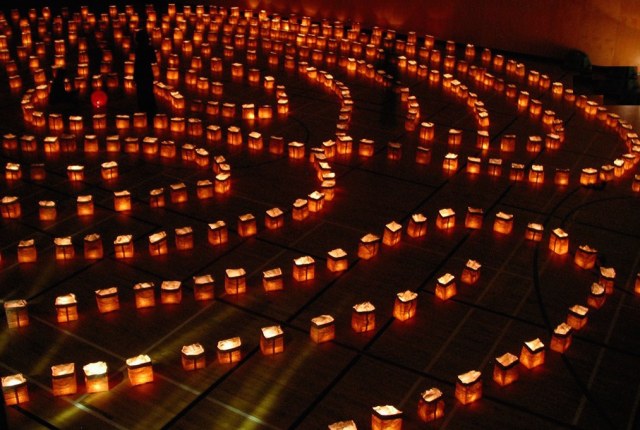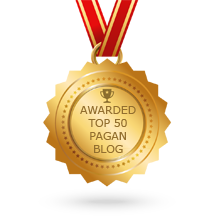Yuletide Celebrations
Todays post focuses on some of the ways the season of Yule is celebrated. Although in many cases the celebration of Yule coincides with the astronomical date of the Winter Solstice, they are distinct in that Yule is a seasonal observance that often lasted longer than the single Sabbat date it is traditionally assigned of Dec. 20/21 (the Winter Solstice).
The season of Yule begins on the date of the Full Moon in late November or the first few weeks of December, and the season continues for two lunar months. In some Saxon-based traditions, the official celebration of the Yuletide does not actually begin until Mothers’ Night (the solstice) and continues for a week or two after this.
These celebrations may last from 10-12 days after the Solstice date which nicely coincides with New Year’s celebrations. During this time, feasts, gifts-giving and gatherings mark the celebrations.
The Witch’s Wheel of the Year uses the semantic of Yule as the name of the Sabbat celebrated on the date of the Winter Solstice. And with this title come all the symbols that make this one of the most joyful to celebrate. However you choose to celebrate this season, light is the underpinning. This aspect relates to the occurrence of the Winter Solstice during the Yuletide season and the cycle of the Light and Dark half of the year. And, in the Northern Hemisphere and Winter’s hold this light is prominent in celebrating ourselves….
These are just a few of the ways the season is honored….
Ancient Beginnings
Celtic Celebration:
 The Celtic Connection
The Celtic Connection
Bonfires were lit in the fields, and crops and trees were “wassailed” with toasts of spiced cider. Children were escorted from house to house with gifts of clove spiked apples and oranges which were laid in baskets of evergreen boughs and wheat stalks dusted with flour. The apples and oranges represented the sun. The boughs were symbolic of immortality (evergreens were sacred to the Celts because they did not “die” thereby representing the eternal aspect of the Divine). The wheat stalks portrayed the harvest, and the flour was accomplishment of triumph, light, and life. Holly and ivy not only decorated the outside, but also the inside of homes, in hopes Nature Sprites would come and join the celebration. A sprig of Holly was kept near the door all year long as a constant invitation for good fortune to visit tthe residents. Mistletoe was also hung as decoration. It represented the seed of the Divine, and at Midwinter, the Druids would travel deep into the forest to harvest it.
The ceremonial Yule log was the highlight of the Solstice festival. In accordance to tradition, the log must either have been harvested from the householder’s land, or given as a gift… it must never have been bought. Once dragged into the house and placed in the fireplace it was decorated in seasonal greenery, doused with cider or ale, and dusted with flour before set ablaze by a piece of last years log, (held onto for just this purpose). The log would burn throughout the night, then smolder for 12 days after before being ceremonially put out. Ash is the traditional wood of the Yule log. It is the sacred world tree of the Teutons, known as Yggdrasil. An herb of the Sun, Ash brings light into the hearth at the Solstice.
Druidry
 The Order of Bards, Ovates and Druids
The Order of Bards, Ovates and Druids
In the Druidic tradition the name of this festival is “Alban Arthan”, Welsh for “Light of Winter”. According to an older and more poetic interpretation, the name is “Alban Arthuan”, meaning “Light of Arthur”. In this poetical image, Arthur is symbolized by the Sun. The Sun dies and is reborn, just as the mythical Arthur is sleeping deep inside a mountain and will wake up again when the people needs his help.
Alban Arthan, the Winter Solstice, takes place every year on the 21st or 22nd of December (Northern Hemisphere).
While Samhain is strongly connected with insular Celtic culture, Alban Arthan is a universal festival, which has been (and still is) celebrated by many peoples and long before the coming of the Celts. The Winter Solstice is probably (together with the Summer Solstice) the oldest seasonal festival of humankind.
Saturnalia in Ancient Rome
 The Magickal History of Yule-Huffington Post
The Magickal History of Yule-Huffington Post
In Ancient Rome the Winter Solstice festival Saturnalia began on December 17 and lasted for seven days.
Saturnalian banquets were held from as far back as around 217 BCE. The festival was held to honor Saturn, the father of the gods and was characterized by the suspension of discipline and reversal of the usual order. Grudges and quarrels were forgotten while businesses, courts and schools were closed. Wars were interrupted or postponed and slaves were served by their masters. Masquerades often occurred during this time.
It was traditional to offer gifts of imitation fruit (a symbol of fertility), dolls (symbolic of the custom of human sacrifice), and candles (reminiscent of the bonfires traditionally associated with pagan solstice celebrations). A mock king was chosen, usually from a group of slaves or criminals, and although he was permitted to behave in an unrestrained manner for seven days of the festival, he was usually killed at the end. The Saturnalia eventually degenerated into a week-long spree of debauchery and crime – giving rise to the modern use of the tern saturnalia, meaning a period of unrestrained license and revelry.
Modern
Fiesta de Santo Tomás in Guatemala

Many Christians celebrate St Thomas’ Day in honor of St Thomas the Apostle on December 21. In Guatemala on this day, Mayan Indians honor the sun god they worshipped long before they became Christians with a dangerous ritual known as the polo voladore, or “flying pole dance”. Three men climb on top of a 50-foot pole. As one of them beats a drum and plays a flute, the other two men wind a rope attached to the pole around one foot and jump. If they land on their feet, it is believed that the sun god will be pleased and that the days will start getting longer. Some churches celebrate St Thomas’ Day on other days in the year.
The ancient Incas celebrated a special festival to honor the sun god at the time of the December solstice. In the 16th century ceremonies were banned by the Roman Catholics in their bid to convert the Inca people to Christianity. A local group of Quecia Indians in Cusco, Peru, revived the festival in the 1950s. It is now a major festival that begins in Cusco and proceeds to an ancient amphitheater a few miles away.
Feast of Juul
 TimeandDate
TimeandDate
The Feast of Juul was a pre-Christian festival observed in Scandinavia at the time of the December solstice. Fires were lit to symbolize the heat, light and life-giving properties of the returning sun. A Yule or Juul log was brought in and burned on the hearth in honor of the Scandinavian god Thor.
A piece of the log was kept as both a token of good luck and as kindling for the following year’s log. In England, Germany, France and other European countries, the Yule log was burned until nothing but ash remained. The ashes were then collected and either strewn on the fields as fertilizer every night until Twelfth Night or kept as a charm and or as medicine.
French peasants believed that if the ashes were kept under the bed, they would protect the house against thunder and lightning. The present-day custom of lighting a Yule log at Christmas is believed to have originated in the bonfires associated with the feast of Juul.
The Dongzhi Festival in China
 How to Celebrate the Dongzhi Festival
How to Celebrate the Dongzhi Festival
On or around the Winter Solstice, Chinese people observe holiday rituals that would be familiar to anyone: gathering with loved ones and eating too much. The favored treat is tangyuan, sticky rice flour balls that are easy to make—and even easier to consume. Families often make the preparation of tangyuan a group activity, which makes sense as the balls symbolize reunion. The balls come in every vivid hue imaginable, but the holiday itself is black and white in origin: its roots are in the philosophy of yin and yang, the balance between light and dark, with the solstice being the meeting point.
Jólablót in Iceland
 Iceland Review
Iceland Review
Many traditions associated with Christmas come from pagan celebrations: yule logs, the lighting of candles, and the honoring of trees, just to name a few. Since the 1970s, Iceland’s pagan community has reclaimed the holiday, with jólablót celebrations that begin on December 1 and continue through the evening of the Winter Solstice. Carrying candles, lighting bonfires, telling ancient legends, and sharing wine from a sacred horn, revelers celebrate in five locations: a city each in the nation’s north, south, east, and west (Reykjavik being the largest); as well as at Pingvellir, site of the world’s first Parliament and Iceland’s former cultural center.



Reblogged this on The Magickal Pen.